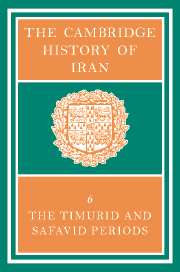Book contents
- Frontmatter
- 1 THE JALAYIRIDS, MUZAFFARIDS AND SARBADĀRS
- 2 TĪMŪR IN IRAN
- 3 THE SUCCESSORS OF TĪMŪR
- 4 THE TÜRKMEN DYNASTIES
- 5 THE SAFAVID PERIOD
- 6 THE SAFAVID ADMINISTRATIVE SYSTEM
- 7 EUROPEAN CONTACTS WITH PERSIA, 1350–1736
- 8 TRADE FROM THE MID-14TH CENTURY TO THE END OF THE SAFAVID PERIOD
- 9 SOCIAL AND INTERNAL ECONOMIC AFFAIRS
- 10 THE EXACT SCIENCES IN TIMURID IRAN
- 11 PERSIAN SCIENCE IN SAFAVID TIMES
- 12 RELIGION IN THE TIMURID AND SAFAVID PERIODS
- 13 SPIRITUAL MOVEMENTS, PHILOSOPHY AND THEOLOGY IN THE SAFAVID PERIOD
- 14 CARPETS AND TEXTILES
- 15 (a) TIMURID ARCHITECTURE
- (b) SAFAVID ARCHITECTURE
- 16 (a) THE PICTORIAL ARTS IN THE TIMURID PERIOD
- (b) THE ARTS IN THE SAFAVID PERIOD
- 17 (a) PERSIAN LITERATURE IN THE TIMURID AND TÜRKMEN PERIODS (782–907/1380–1501)
- (b) HĀFIZ AND HIS CONTEMPORARIES
- (c) PERSIAN LITERATURE IN THE SAFAVID PERIOD
- 18 PERSIAN POETRY IN THE TIMURID AND SAFAVID PERIODS
- Bibliographies
- Plate section
- Plate section
- Plate section
- Maps
- References
(b) - THE ARTS IN THE SAFAVID PERIOD
Published online by Cambridge University Press: 28 March 2008
- Frontmatter
- 1 THE JALAYIRIDS, MUZAFFARIDS AND SARBADĀRS
- 2 TĪMŪR IN IRAN
- 3 THE SUCCESSORS OF TĪMŪR
- 4 THE TÜRKMEN DYNASTIES
- 5 THE SAFAVID PERIOD
- 6 THE SAFAVID ADMINISTRATIVE SYSTEM
- 7 EUROPEAN CONTACTS WITH PERSIA, 1350–1736
- 8 TRADE FROM THE MID-14TH CENTURY TO THE END OF THE SAFAVID PERIOD
- 9 SOCIAL AND INTERNAL ECONOMIC AFFAIRS
- 10 THE EXACT SCIENCES IN TIMURID IRAN
- 11 PERSIAN SCIENCE IN SAFAVID TIMES
- 12 RELIGION IN THE TIMURID AND SAFAVID PERIODS
- 13 SPIRITUAL MOVEMENTS, PHILOSOPHY AND THEOLOGY IN THE SAFAVID PERIOD
- 14 CARPETS AND TEXTILES
- 15 (a) TIMURID ARCHITECTURE
- (b) SAFAVID ARCHITECTURE
- 16 (a) THE PICTORIAL ARTS IN THE TIMURID PERIOD
- (b) THE ARTS IN THE SAFAVID PERIOD
- 17 (a) PERSIAN LITERATURE IN THE TIMURID AND TÜRKMEN PERIODS (782–907/1380–1501)
- (b) HĀFIZ AND HIS CONTEMPORARIES
- (c) PERSIAN LITERATURE IN THE SAFAVID PERIOD
- 18 PERSIAN POETRY IN THE TIMURID AND SAFAVID PERIODS
- Bibliographies
- Plate section
- Plate section
- Plate section
- Maps
- References
Summary
Shah Ismā'īl was of Tükmen blood on his mother's side and he deliberately made the Āq Quyūnlū capital of Tabrīz his first capital: he took over the machinery of government centred in that city, and it seems that he also took over the artists of the book from the school established there by Uzun Hasan and his son Ya'qub (883–96/1479–90), which we have seen to have continued the Timurid tradition of Herat painting through the second half of the 9th/15th century. A key manuscript to illustrate the transition to the early Safavid style is the Khamsa of Nizāmī copied for Ya'qūb at Tabrīz in 1481 (Topkapi Sarayi, Hazine 762), to which a dozen miniatures were added later, apparently in 910/1504–5, according to a date on one of them; and evidently still at Tabrīz (pl. 36), for they show the Qizilbāsh projecting kulāh, the Haidarī tāj adopted by Haidar, father of Ismā'īl, as the sign of his adherents in the Safaviyya. These miniatures preserve the elegance and decorative quality of the royal Türkmen school with no interest in spatial organisation. There is another well-known manuscript whose miniatures also show an early type of Safavid kulāh, one of them bearing the same date 910/1504–5 (pl. 59). This is a copy of the Dastān I Jamāl u Jalāl of the poet Āsafī in the Uppsala University Library. These miniatures show the same disregard for spatial organisation, but a much greater interest in landscape, rendered in a particularly rich palette for the luxurious vegetation.
- Type
- Chapter
- Information
- The Cambridge History of Iran , pp. 877 - 912Publisher: Cambridge University PressPrint publication year: 1986



